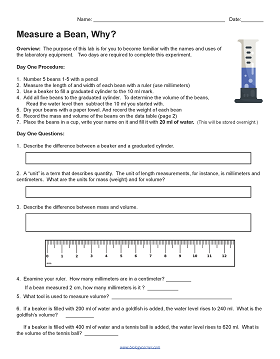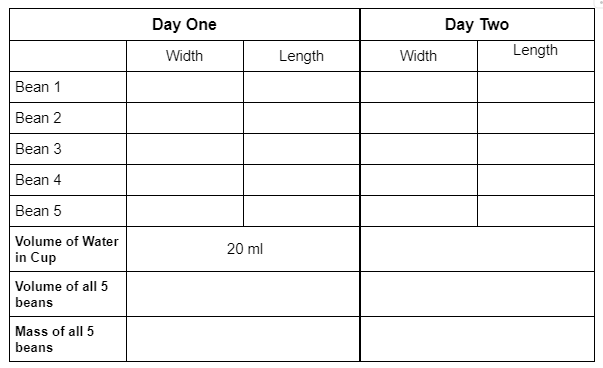Measure a Bean, Why?
 Overview: The purpose of this lab
is for you to become familiar with the names and uses of the laboratory equipment.
Two days are required to complete this experiment.
Overview: The purpose of this lab
is for you to become familiar with the names and uses of the laboratory equipment.
Two days are required to complete this experiment.
Day One Procedure:
1. Number 5 beans
1-5 with a pencil
2. Measure the length of and width of each bean with a ruler (use millimeters)
3. Use a beaker to fill a graduated cylinder to the 10 ml mark.
4. Add all five beans to the graduated cylinder. To determine the volume
of the beans, see how many ml the water raised. (make sure to subtract the
10 ml you started with
5. Dry your beans with a paper towel. And record the weight of each bean
using a scale or balance.
6. Place all five beans in a cup, write your name on the cup and fill it
with 15 ml of water. (This will be stored overnight.)
Day One Questions:
1. Describe the difference between a beaker and a graduated cylinder.
2. A "unit" is a term that describes quantity. The unit of length measurements, for instance, is millimeters and centimeters. What are the units for mass (weight) and for volume?
3. Describe the difference between mass and volume.
4. Examine your ruler. How many millimeters are in a centimeter? _________
If a bean measured 2 cm, how many millimeters is it ? ___________
5. What tool(s) is used to measure volume? _________
6. If a beaker is filled with 200
ml of water and a goldfish is added, the water level rises to 240 ml.
What is
the goldfish's volume? ___________
If a beaker is filled with 400
ml of water and a tennis ball is added, the water level rises to 620 ml.
What
is the volume of the tennis ball? _____________
Day 2 - Procedure
- Measure the amount of water left in the cup by carefully pouring the water into a graduated cylinder
- Remove the beans from the water and record their length and widths on the data table.
- Record the volume and mass of the five beans.
Day 2 Questions
7.
Describe how the bean's width and length change after soaking.
8. Describe how the bean's mass changed after soaking.
9. Describe how the bean's volume changes after soaking.
10. Explain why you observed these changes. (What happened to the beans?)

Related Worksheets on the Scientific Method
Equipment Station Lab – a station lab activity where students move through stations and perform tasks with scientific equipment
Tools and Measurements – how to use various tools in the lab, such as a graduated cylinder, ruler, and beaker
Lab Safety Contract – students sign this contract after learning about lab safety
Using a Micropipette – activity explores how to use a micropipette to measure small volumes

